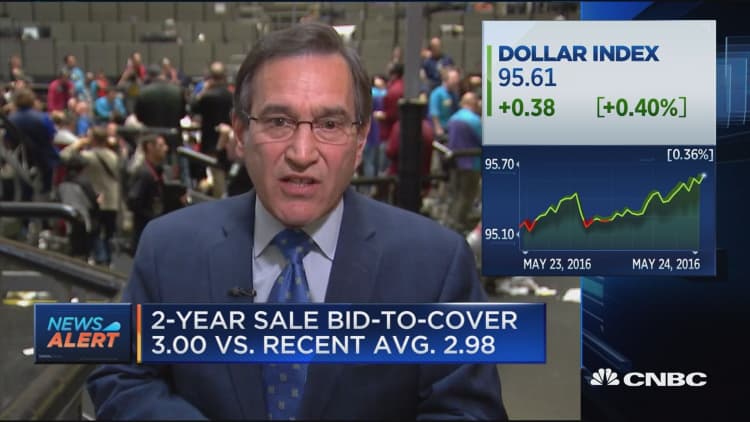
Buyers swarmed the two-year Treasury auction, at the same time market expectations for a Fed rate hike were building.
While many see the success of Tuesday afternoon's auction as the result of a liquidity issue, the continued flattening of the yield curve between and 10-year notes could be seen as an ominous sign that the market is worried about the Fed tightening.
"By any historical measure, it was a very, very strong auction, and this comes in the face of rising expectation for a June rate hike. Those two things seem incongruous. I think what we have to look at is the structure of the market. You have liquidity issues that lead larger real money investors to use the auctions for liquidity options, to get into large amounts of bonds," said Tom Simons, money market economist at Jefferies.
The $26 billion in two-year notes was auctioned at the highest yield since December — 0.92 percent, after being bid on a when-issued basis at 0.94 percent. The ratio of bids to the amount offered was 3.00, well above the 2.64 at the last auction. Primary brokers took down only 18 percent of the auction, while indirect bidding was strong at 49.8 and direct bidding was at a multiyear high of 32.5 percent. The nondealers have not taken that high a percent at auction for 13 years.. Post auction the two-year was yielding 0.90 percent.
Read MoreBond market stares down the Fed
The strength of the auction of two-year notes was a surprise to traders, who had anticipated some weakness after the Fed started talking up a rate hike for this summer. "I guess the market cheapened up. There really was not a sign it was going to be that well-received. It was the best auction since 2003. But I don't think auctions tell you that much ... maybe it's more about liquidity at a point in time," said Brian Edmonds, head of interest rate trading at Cantor Fitzgerald.
Foreign buyers have been seeking the higher yields of U.S. Treasurys, compared to the negative two-year yields in Germany and Japan.
The spread on the yield curve has been hovering at 2007 levels for a while but Fed jawboning has led to a move to an even narrower level, as low as 92 Tuesday before going higher. The question is whether it is sending a signal, as a flattening curve often precedes a weaker economy or recession. Traders linked it to fears about the Fed.
"It could be that, but it isn't necessarily that. If you look up the textbook explanation of why this would happen, that was the answer you were going to get — that it's doubts on the market's part that the Fed could hike," Simons said.
But Peter Boockvar, chief strategist at The Lindsey Group, said the flattening curve and the auction could be a sign. The auction was underway as fed funds futures were pricing in a 40 percent chance for a June hike and a 68 percent chance of a July hike, he added. Those levels were close to 30 percent and 60 percent, respectively, on Monday.
Read MoreThis key recession signal is broken
"I believe there are two possibilities for the strong demand, 1) the attractiveness of the yield (relatively speaking) as just stated but also due to 2) many doubts at the U.S. economy's ability to handle higher rates. Clear evidence of this is the continued flattening of the yield curve recently and the December fed funds contract which is pricing in just a 14 percent of a second hike this year. Stocks so far have been unperturbed by the growing likelihood of another hike and thus assumes that what happened in January and February after the December hike won't happen again. We'll soon see because the yield curve isn't as confident," wrote Boockvar in an email.
The 10-year was yielding about 1.85 percent Tuesday afternoon, after the 1 p.m. EDT two-year auction. The 10-year yield has been kept low by buyers who find it more attractive than other low-yielding sovereigns.
"As to the long end of the curve, as part of my belief that the end of the commodity bear market combined with services inflation running at 3 percent will result in headline inflation prints of 2 percent towards the latter part of 2016, I think long rates bottomed in mid-February at 1.66 percent, early April at 1.69 percent and last week at 1.70 percent (higher lows?)," he wrote.


